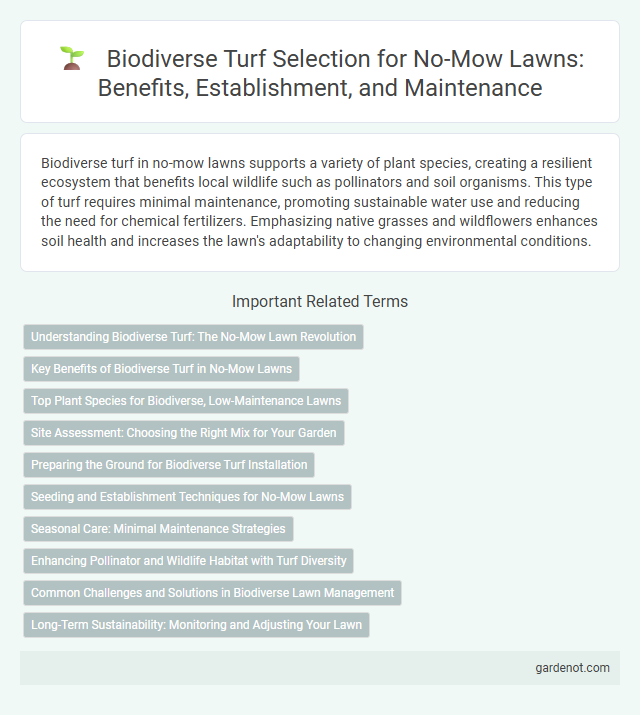Biodiverse turf in no-mow lawns supports a variety of plant species, creating a resilient ecosystem that benefits local wildlife such as pollinators and soil organisms. This type of turf requires minimal maintenance, promoting sustainable water use and reducing the need for chemical fertilizers. Emphasizing native grasses and wildflowers enhances soil health and increases the lawn's adaptability to changing environmental conditions.
Understanding Biodiverse Turf: The No-Mow Lawn Revolution
Biodiverse turf consists of a variety of grasses, wildflowers, and native plants that create resilient, low-maintenance lawns requiring minimal mowing. This no-mow lawn approach promotes soil health, supports local pollinators, and enhances ecosystem biodiversity by providing habitats for insects and birds. Embracing biodiverse turf reduces water usage and chemical inputs, making it an eco-friendly alternative to traditional lawns.
Key Benefits of Biodiverse Turf in No-Mow Lawns
Biodiverse turf in no-mow lawns supports soil health by promoting microbial activity and natural nutrient cycling, reducing the need for synthetic fertilizers. It enhances local ecosystems by providing habitats for pollinators such as bees and butterflies, contributing to increased biodiversity. This low-maintenance turf also conserves water and reduces carbon emissions associated with mowing and chemical treatments.
Top Plant Species for Biodiverse, Low-Maintenance Lawns
Biodiverse no-mow lawns thrive with top plant species such as clover (Trifolium repens), fescues (Festuca spp.), and native wildflowers like oxeye daisy (Leucanthemum vulgare). These species support pollinators, enhance soil health, and require minimal maintenance compared to traditional turfgrass. Incorporating deep-rooted grasses and nitrogen-fixing plants promotes ecosystem resilience and reduces the need for fertilizers and irrigation.
Site Assessment: Choosing the Right Mix for Your Garden
Conducting a thorough site assessment involves analyzing soil type, sunlight exposure, and local climate to select a biodiverse no-mow turf mix that thrives naturally. Choosing a blend of native grasses and wildflowers enhances resilience, supports pollinators, and reduces maintenance needs. Tailoring the mix to your garden's specific conditions promotes ecological balance and a sustainable, vibrant lawn.
Preparing the Ground for Biodiverse Turf Installation
Preparing the ground for biodiverse turf installation involves removing existing grass and weeds to reduce competition for native plants, followed by loosening the soil to enhance root penetration and moisture retention. Incorporating organic compost enriches the soil with nutrients, promoting a healthy ecosystem that supports diverse flora and fauna. Proper grading ensures effective water drainage, preventing erosion and fostering optimal growth conditions for the biodiverse lawn.
Seeding and Establishment Techniques for No-Mow Lawns
Seeding for biodiverse no-mow lawns involves selecting a mix of native grasses, wildflowers, and low-growing ground covers that thrive without frequent mowing, enhancing ecological benefits and soil health. Establishment techniques include soil preparation through minimal disturbance, careful seedbed creation, and consistent moisture management to ensure strong root development and species diversity. Avoiding aggressive fertilizers and reducing irrigation supports resilient, drought-tolerant plant communities that create vibrant, sustainable no-mow turf ecosystems.
Seasonal Care: Minimal Maintenance Strategies
Biodiverse turf thrives with minimal mowing by promoting native grasses and wildflowers that adapt to seasonal changes naturally, reducing the need for frequent trimming. Implementing seasonal care such as selective weeding, occasional aeration, and organic fertilization supports soil health and encourages diverse plant growth. This low-maintenance approach enhances ecosystem resilience while saving time and resources throughout the year.
Enhancing Pollinator and Wildlife Habitat with Turf Diversity
Biodiverse turf promotes a rich ecosystem by integrating native wildflowers, clover, and diverse grass species, which significantly enhance pollinator habitats and support wildlife diversity. This mix attracts bees, butterflies, and beneficial insects essential for ecosystem health while improving soil structure and resilience. Turf diversity reduces reliance on chemical inputs, fostering sustainable lawn management that benefits local flora and fauna.
Common Challenges and Solutions in Biodiverse Lawn Management
Biodiverse lawns face challenges such as uneven growth, weed invasion, and soil nutrient imbalances. Implementing adaptive mowing schedules, selective weeding, and organic soil amendments can mitigate these issues effectively. Regular monitoring of native plant species diversity enhances resilience and promotes sustainable turf health.
Long-Term Sustainability: Monitoring and Adjusting Your Lawn
Biodiverse turf supports long-term sustainability by fostering a variety of native grasses, wildflowers, and beneficial insects that enhance soil health and resilience. Regular monitoring of plant species composition and soil moisture levels allows for precise adjustments in mowing frequency and watering practices to maintain ecological balance. This adaptive management approach reduces resource inputs and promotes a thriving, self-sustaining no-mow lawn ecosystem.
Biodiverse turf Infographic

 gardenot.com
gardenot.com